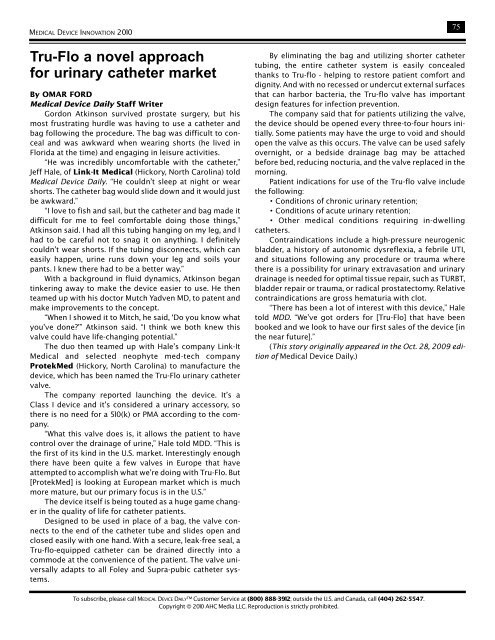MEDICAL DEVICE INNOVATION - Medical Device Daily
MEDICAL DEVICE INNOVATION - Medical Device Daily
MEDICAL DEVICE INNOVATION - Medical Device Daily
Create successful ePaper yourself
Turn your PDF publications into a flip-book with our unique Google optimized e-Paper software.
<strong>MEDICAL</strong> <strong>DEVICE</strong> <strong>INNOVATION</strong> 2010<br />
Tru-Flo a novel approach<br />
for urinary catheter market<br />
By OMAR FORD<br />
<strong>Medical</strong> <strong>Device</strong> <strong>Daily</strong> Staff Writer<br />
Gordon Atkinson survived prostate surgery, but his<br />
most frustrating hurdle was having to use a catheter and<br />
bag following the procedure. The bag was difficult to conceal<br />
and was awkward when wearing shorts (he lived in<br />
Florida at the time) and engaging in leisure activities.<br />
“He was incredibly uncomfortable with the catheter,”<br />
Jeff Hale, of Link-It <strong>Medical</strong> (Hickory, North Carolina) told<br />
<strong>Medical</strong> <strong>Device</strong> <strong>Daily</strong>. “He couldn’t sleep at night or wear<br />
shorts. The catheter bag would slide down and it would just<br />
be awkward.”<br />
“I love to fish and sail, but the catheter and bag made it<br />
difficult for me to feel comfortable doing those things,”<br />
Atkinson said. I had all this tubing hanging on my leg, and I<br />
had to be careful not to snag it on anything. I definitely<br />
couldn’t wear shorts. If the tubing disconnects, which can<br />
easily happen, urine runs down your leg and soils your<br />
pants. I knew there had to be a better way.”<br />
With a background in fluid dynamics, Atkinson began<br />
tinkering away to make the device easier to use. He then<br />
teamed up with his doctor Mutch Yadven MD, to patent and<br />
make improvements to the concept.<br />
“When I showed it to Mitch, he said, ‘Do you know what<br />
you’ve done’” Atkinson said. “I think we both knew this<br />
valve could have life-changing potential.”<br />
The duo then teamed up with Hale’s company Link-It<br />
<strong>Medical</strong> and selected neophyte med-tech company<br />
ProtekMed (Hickory, North Carolina) to manufacture the<br />
device, which has been named the Tru-Flo urinary catheter<br />
valve.<br />
The company reported launching the device. It’s a<br />
Class I device and it’s considered a urinary accessory, so<br />
there is no need for a 510(k) or PMA according to the company.<br />
“What this valve does is, it allows the patient to have<br />
control over the drainage of urine,” Hale told MDD. “This is<br />
the first of its kind in the U.S. market. Interestingly enough<br />
there have been quite a few valves in Europe that have<br />
attempted to accomplish what we’re doing with Tru-Flo. But<br />
[ProtekMed] is looking at European market which is much<br />
more mature, but our primary focus is in the U.S.”<br />
The device itself is being touted as a huge game changer<br />
in the quality of life for catheter patients.<br />
Designed to be used in place of a bag, the valve connects<br />
to the end of the catheter tube and slides open and<br />
closed easily with one hand. With a secure, leak-free seal, a<br />
Tru-flo-equipped catheter can be drained directly into a<br />
commode at the convenience of the patient. The valve universally<br />
adapts to all Foley and Supra-pubic catheter systems.<br />
75<br />
By eliminating the bag and utilizing shorter catheter<br />
tubing, the entire catheter system is easily concealed<br />
thanks to Tru-flo - helping to restore patient comfort and<br />
dignity. And with no recessed or undercut external surfaces<br />
that can harbor bacteria, the Tru-flo valve has important<br />
design features for infection prevention.<br />
The company said that for patients utilizing the valve,<br />
the device should be opened every three-to-four hours initially.<br />
Some patients may have the urge to void and should<br />
open the valve as this occurs. The valve can be used safely<br />
overnight, or a bedside drainage bag may be attached<br />
before bed, reducing nocturia, and the valve replaced in the<br />
morning.<br />
Patient indications for use of the Tru-flo valve include<br />
the following:<br />
• Conditions of chronic urinary retention;<br />
• Conditions of acute urinary retention;<br />
• Other medical conditions requiring in-dwelling<br />
catheters.<br />
Contraindications include a high-pressure neurogenic<br />
bladder, a history of autonomic dysreflexia, a febrile UTI,<br />
and situations following any procedure or trauma where<br />
there is a possibility for urinary extravasation and urinary<br />
drainage is needed for optimal tissue repair, such as TURBT,<br />
bladder repair or trauma, or radical prostatectomy. Relative<br />
contraindications are gross hematuria with clot.<br />
“There has been a lot of interest with this device,” Hale<br />
told MDD. “We’ve got orders for [Tru-Flo] that have been<br />
booked and we look to have our first sales of the device [in<br />
the near future].”<br />
(This story originally appeared in the Oct. 28, 2009 edition<br />
of <strong>Medical</strong> <strong>Device</strong> <strong>Daily</strong>.)<br />
To subscribe, please call <strong>MEDICAL</strong> <strong>DEVICE</strong> DAILY Customer Service at (800) 888-3912; outside the U.S. and Canada, call (404) 262-5547.<br />
Copyright © 2010 AHC Media LLC. Reproduction is strictly prohibited.
















